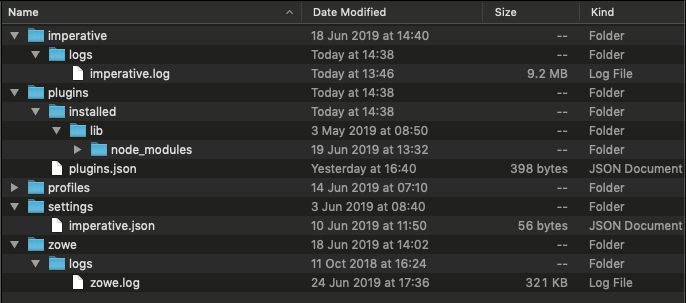Using individual commands for Zowe CLI troubleshooting
Using individual commands for Zowe CLI troubleshooting
Follow these instructions to gather specific pieces of information to help troubleshoot Zowe™ CLI issues.
Identify the currently installed CLI version
Issue the following command:
zowe -V
The exact Zowe CLI version may vary depending upon if the @latest or @zowe-v1-lts, or @zowe-v2-lts version is installed.
You can also display the version of your globally-installed Zowe CLI through the following NPM command:
npm list -g @zowe/cli
More information regarding versioning conventions for Zowe CLI and plug-ins is located in Versioning Guidelines.
Identify the currently installed versions of plug-ins
Issue the following command:
zowe plugins list
The output describes version and the registry information.
Environment variables
The following settings are configurable via environment variables:
Log levels
Environment variables are available to specify logging level and the CLI home directory.
Important! Setting the log level to TRACE or ALL might result in "sensitive" data being logged. For example, command line arguments will be logged when TRACE is set.
For more information about logging and environment variables, see Setting CLI log levels.
CLI daemon mode
By default, the CLI daemon mode binary creates or reuses a file in the user's home directory each time a Zowe CLI command runs. In some cases, this behavior might be undesirable. For example, the home directory resides on a network drive and has poor file performance. For information about how to change the location that the daemon uses, see Setting CLI daemon mode properties.
Home directory
You can set the location on your computer for the Zowe CLI home directory, which contains log files, profiles, and plug-ins for the product.
The default .zowe folder is created when you issue your first Zowe CLI command. If you change the location of the folder, you must reinstall plug-ins and recreate or move profiles and log files that you want to retain. In some cases, you might want to maintain a different set of profiles in multiple folders, then switch between them using the environment variable.
For information about setting an environment variable for the Zowe CLI home directory, see Setting the CLI home directory.
The values for these variables can be echoed.
Home directory structure

Location of logs
There are two sets of logs to be aware of:
Imperative CLI Framework log, which generally contains installation and configuration information.
Zowe CLI log, which contains information about interaction between CLI and the server endpoints.
Analyze these logs for any information relevant to your issue.
Profile configuration
The profiles folder stores connection information.
Important! The profile directory might contain "sensitive" information, such as your mainframe password. You should obfuscate any sensitive references before providing configuration files.
Note: While the profile directory can still be used in Zowe CLI v2, it has been deprecated in favor of v2 team configuration files.
Node.js and npm
Zowe CLI is compatible with the currently supported Node.js LTS versions. For an up-to-date list of supported LTS versions, see Node.js.org.
To gather the Node.js and npm versions installed on your computer, issue the following commands:
node --version
npm --version
npm configuration
If you are having trouble installing Zowe CLI from an npm registry, gather your npm configuration to help identify issues with registry settings, global install paths, proxy settings, etc...
npm config ls -l
npm log files
In case of errors, npm creates log files in the npm_cache\_logs location. To get the npm_cache location for a specific OS, run the following command:
npm config get cache
By default, npm keeps only 10 log files, but sometimes more are needed. Increase the log count by issuing the following command:
npm config set logs-max 50
This command increases the log count to 50, so that more log files will be stored on the system. Now you can run tests multiple times and not lose the log files. The logs can be passed to Support for analysis.
As the log files are created only when an npm command fails, but you are interested to see what is executed, you can increase the log level of npm. Issue the following command:
npm config set loglevel verbose
With this change, you can see all actions taken by npm on the stdout. If the command is successful, it still does not generate a log file.
The available log levels are: "silent", "error", "warn", "notice", "http", "timing", "info", "verbose", "silly", and "notice". "Notice" is the default.
Alternatively, you can pass
--loglevel verboseon the command line, but this only works with npm related commands. By setting log level in the config, it also works when you issue somezowecommands that use npm (for example,zowe plugins install @zowe/cics).